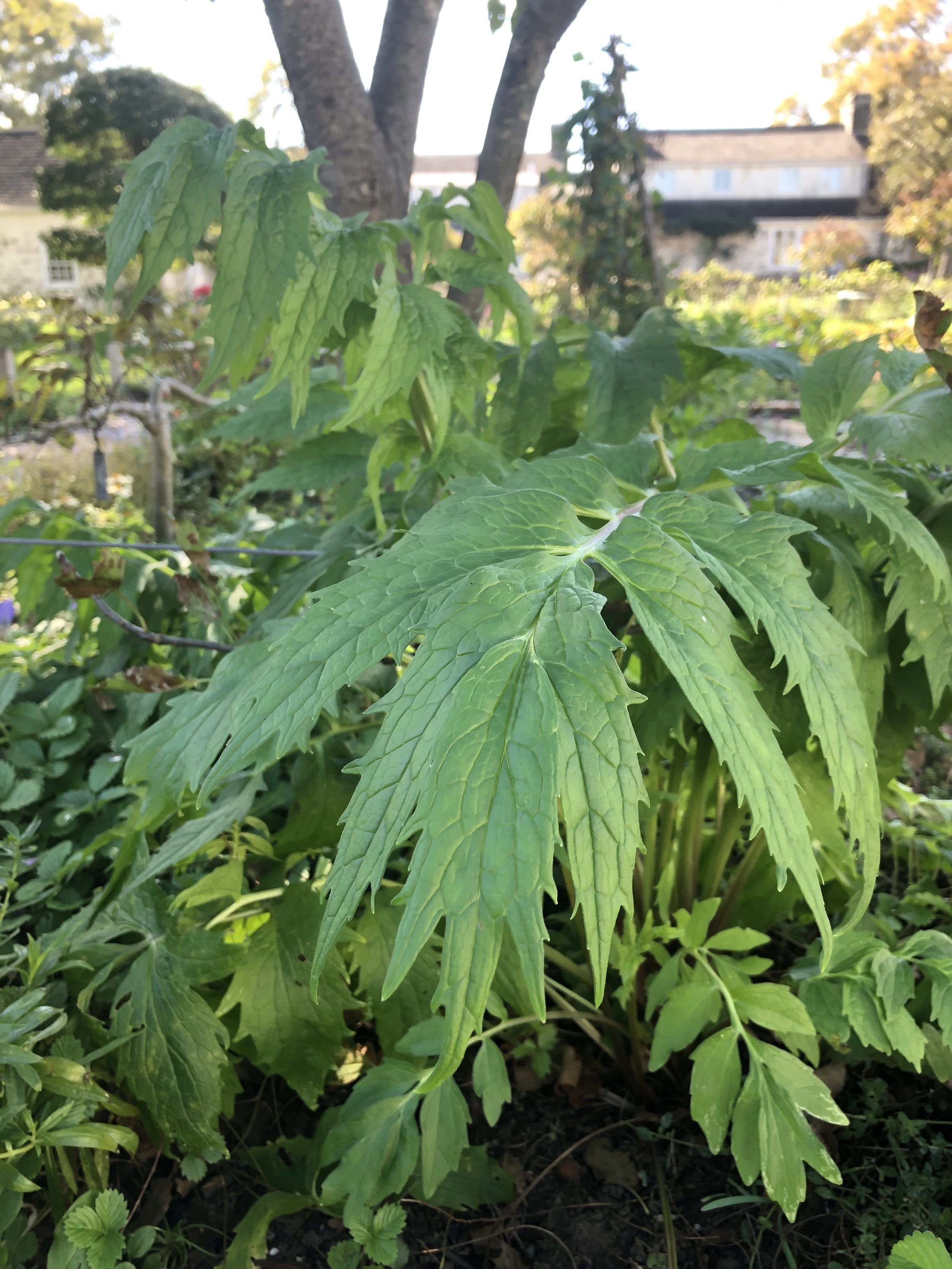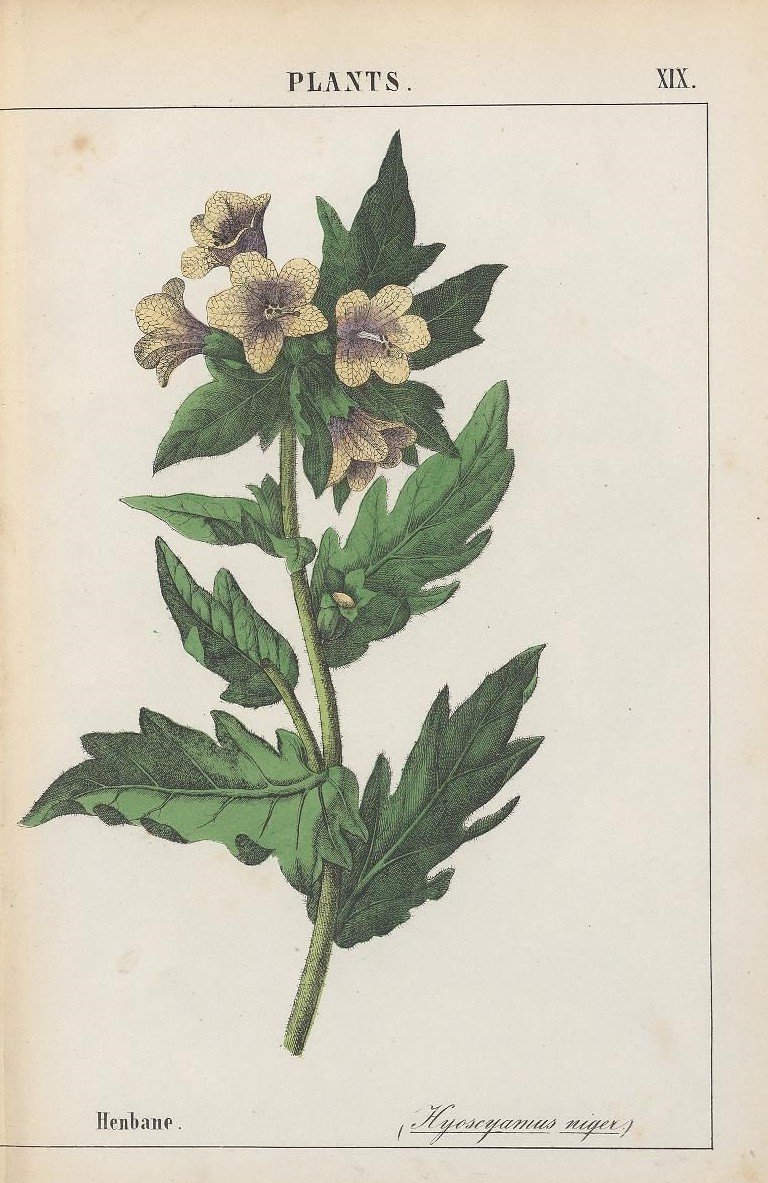The World's Most Magical Plants
Emily Ellis
Bunny Mellon also enjoyed reading about the spooky side of plants - this book was given to her by Paul.
There’s no doubt that plants are magical. They can heal us of our most devastating wounds and illnesses, make us see and experience unconceivable things, and, according to some, ensnare love, protect us from evil, and curse our enemies. Botanists around the world are still striving to understand exactly what makes plants adapt and function in such incredible ways - evidence that there is an undeniable mystery to them, regardless of what you believe!
Certain plants, however, have made far more appearances in potions, spell books, and ceremonies than others - for purposes both good evil. It is this spooky, magical flora that we’re celebrating in honor of Halloween this year.
Scroll down to read about six of the world’s most magical plants. Happy Halloween!
Vervain (Verbana)
Vervain growing in the formal garden.
One of the plants that appears most frequently in potion ingredients and spells is vervain - a seemingly innocuous herb with a long history of magical use.
Sometimes known as the “Enchanter’s Herb”, Vervain was treated as a sacred plant by almost every culture who could get their hands on it, likely due to its anti inflammatory and healing properties. In ancient Egypt, it was believed to have first sprung from the tears of the goddess Isis, and in Christianity, it was used to treat Christ’s wounds on the cross.
Because of its reputation as a holy herb throughout its wide native range (varieties are found in the Americas, Asia and parts of Europe and Africa,) it was often used for protection against dangers including lightning strikes, evil spirits and vampires. As an added bonus, it’s also a hardy plant that looks great in garden borders with its delicate clusters of flowers and serrated leaves.
Henbane (Hyoscyamus niger)
The instructive picture book, or, Lessons from the vegetable world. Edmonston & Douglas, 1858.
It’s no wonder plants that help you see and experience interesting and terrifying things have long been associated with magic. Henbane, also known as “the witch’s drug,” is one of several plants in the Solanaceae (nightshade) family that contains alkaloids including hyoscine, hyoscyamine, and atropine, which can cause powerful hallucinations.
Native to Europe, henbane not only looks rather spooky with its green petals and black center, it has a long history as a poison, medicinal and ritualistic plant across that continent. When mixed with fat an applied as a salve, henbane is absorbed through the skin and is said to give one the dizzying sensation of flight: the reason it is the key ingredient in witch’s ointment. However, it can be lethal in large doses, so we don’t recommend picking some for a little Halloween fun.
In some parts of the U.S., henbane, which belongs to the nightshade family, is classified as a noxious weed, so be sure to keep children and pets away if you spot it growing on the roadside.
Datura (Datura stramonium)
It’s likely you’ve seen these pretty pinwheel-shaped flowers growing in your backyard late in the summer. Datura stramonium, native to North and Central America and now widespread throughout the world, has been used for magical, ceremonial and medicinal purposes for centuries. Like henbane, datura can have hallucinogenic effects when absorbed through the skin as a lotion, causing those who used it to embark on spiritual journeys or enter a trance; in medieval Europe, evidence suggests that during the Spanish Inquisition, the use of the plant could lead to persecution for witchcraft.
While datura has been used safely by experienced medicine people, herbalists, and shamans around the world for hundreds of years, it has also been employed for more nefarious purposes. Plants in its family have been used to reduce unwilling imbibers into a zombie-like state; Devil’s Breath or scopolamine, a drug made primarily from the seeds of flowers in the daturae tribe, has been called the world’s “Most Dangerous Drug” due to its ability to make victims extremely suggestible, and has been linked to countless crimes in Central and South America.
In the English-speaking world, common names for datura include devil’s snare, thornapple, hell's bells, devil's trumpet, devil's weed, stinkweed, locoweed, Beelzebub’s twinkie, and devil's cucumber - nomenclature indicative of its trouble-making reputation. However, the plant’s not all bad: its medicinal properties have proved useful for pain relief and fevers.
wolfsbane (Aconitum)
Monkshood or wolfsbane (so named because it was historically used to poison animal bait) has long been associated with the supernatural.
Native to mountainous regions in western and central Europe, most species of the plant contain the highly toxic aconitine. According to Greek mythology, wolfsbane’s poisonous sap first dripped from the mouth of the hell-guarding three-headed dog Cerebus - perhaps our favorite origin myth for a plant!
Since ancient times, poison made from wolfsbane has been used to coat swords and arrows in battle, execute criminals, commit murder, and has made its way into many spells and rituals. In medieval Europe, some magical uses for the plant wrapping wolfsbane seeds in lizard’s skin and carrying them to become invisible (if you ever try this, please report back!), warding off werewolves and vampires, and shapeshifting into animals.
If you do decide to use wolfsbane in your magic-making - or just to add some deep purple to your garden - be sure to wear gloves, as gardeners have died from handling the plant. Another fun fact about this notorious flower: it belongs to the same family as the far less sinister buttercup!
Artemisia
This silvery artemesia growing between the paving stones in the formal garden is looking extra spooky as it begins to die back.
Plants in the artemisia family (which include wormwood and mugwort) are not only a beautiful in gardens, but are among the world’s most ancient magical herbs.
Many historians believe that the latin name for the plant refers to Artemis, the moon goddess in Greek mythology, although it’s possible that it also references ancient botanist and herbalist Artemisia II of Caria, who died in 350 BC. Whatever the origins of its name, artemisia has long been associated with powerful women - and has a rich history of use in magic, ritual and medicine across its range.
Magical use for artemisia include luring love, cleansing, protection from accidents and evil spirits, and divination. As some plants in the family contain thujone, a hallucinogenic compound, researchers believe that folks in Asia, Europe, and North America have used it to bring on visions and dreams since the Stone Age. Wormwood is also a key ingredient in absinthe - an infamous neon-green liquor banned in many place due to the belief that it could make drinkers behave dangerously and erratically (it’s since been proven that that was mostly the fault of the alcohol, not the wormwood).
Less magical and romantic - but no less important - uses for artemisia include expelling intestinal parasites from the digestive tract, which is how wormwood gets its name.
Blackthorn
John Myers / Blackthorn Tunnel / CC BY-SA 2.0 via Wikimedia Commons
Blackthorn, a thorny shrub in the rose family, has an especially sinister reputation in European folklore. Native to Europe, western Asia, and northern Africa, it has long been associated with darkness and death, in part due to the appearance of its twisted, spiky branches, which are especially stark in the winter months. In Celtic folklore, unfriendly fairies are said to guard the trees, and will burn down the house of anyone who dares to cut one down.
Blackthorns also have a long association with witchcraft and dark magic; during the seventeenth century when fear of witches was especially rampant, it was said that witches used thorny blackthorn wands and blackthorn walking sticks to curse people and wreak general havoc. In 1670, a Major Thomas Weir of Edinburgh was executed for witchcraft along with his blackthorn walking stick.
In reality, blackthorn’s dark reputation is the result of ignorance and superstition: they are an attractive and useful tree that provides wonderful habitat for wildlife their native range.
Want to learn about more magical plants, and the ways they have been used throughout history? Hop on your broom and fly on over to our Fantastic Flora Website: https://www.fantasticflora.online.







